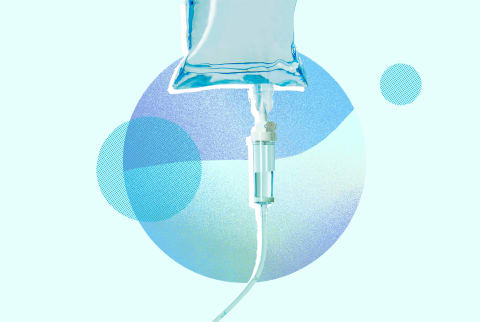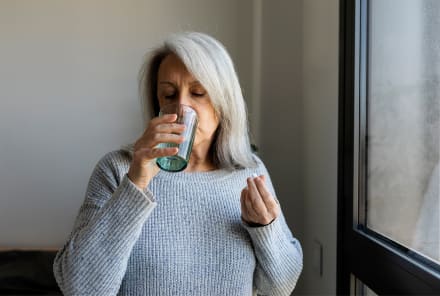Advertisement
NAD IV Therapy: What Is This Trendy New Treatment & Is It Safe?



Supplements that boost nicotinamide adenine dinucleotide (NAD+) have started piquing the public's interest. But now there's another trendy new way to increase the level of this coenzyme in your bloodstream: intravenous (IV) NAD+ therapy. This treatment has been popping up in major metropolitan areas and "wellness hubs," thanks to the popularity of IV therapy bars—also known as IV drip bars—that offer infusions of vitamins and other nutrients.
So what's the verdict on this integrative treatment, and does it warrant the fanfare? We investigated.
What is IV NAD+ therapy?
During IV NAD+ therapy, NAD+ is administered through a vein (intravenously) in a standard saline solution. NAD+ is a coenzyme found in all cells of the body and is involved in a number of functions, including the production of energy in the mitochondria, DNA repair, cell survival, and metabolism. Research suggests that supporting NAD+ may be beneficial for those whose NAD+ levels are declining, a natural part of the aging process. NAD+ levels can also decline through things like oxidative stress and high-fat, high-sugar diets1.
It is not the only way to support NAD+ levels in the body, of course. It is also possible to increase NAD+ levels through oral supplementation of one of its precursors, such as niacin (vitamin B3), nicotinamide, and nicotinamide riboside (NR), the last option being a direct precursor2, and has been shown to be the most effective at supporting your natural levels of NAD+. You can also support natural levels of NAD+ by lifestyle choices, such as regular HIIT workouts and caloric restriction and fasting diets.
Is IV NAD+ therapy safe?
First up: Any IV treatment also carries a small risk of bleeding and infection at the site where the needle is placed in the skin or getting too much fluid infused. IV infusions may be a common medical procedure, but they are still a medical procedure.
The second safety concern is where you are getting it, notes functional and integrative medicine practitioner Roxanna Namavar, M.D., board-certified psychiatrist and fellow in the American Academy of Anti-Aging Medicine, who uses it at her own practice. "No matter what IV therapy you are getting, you want to make sure your practitioner knows where the ingredient is sourced, and how it is compounded. They should also tailor your infusion treatments to you: It shouldn't feel like you're picking things off a menu. Your practitioner should look at your lab work, symptoms, and goals and create a protocol that is specific to your needs."
This concern comes to light most notably with the large amounts of IV bars that have popped up lately, most without much regulation. The U.S. Federal Trade Commission recently took action against an IV drip bar for making unsupported health claims3 about their ability to treat serious illnesses such as cancer, multiple sclerosis, or congestive heart failure.
If done under the supervision of a responsible health care practitioner, however, Namavar says there are no significant safety concerns. She notes that some patients may be sensitive to IV NAD+ therapy, specifically, and experience discomfort such as warming of the chest and nausea. Wally Taylor, M.D., a functional medicine physician with Texas Integrative Medicine in Austin, Texas, notes similarly, "One of the things about NAD+ is that you can't infuse it too quickly without it being pretty uncomfortable." He says some of his patients, "say they feel like they're having symptoms of a heart attack, but when we look at their heart monitor, we don't see any evidence of that." He has found that breathing high-concentration oxygen during the infusion can reduce some of these side effects.
"Any time you're giving treatments intravenously, there could be problems of one sort or another," says Taylor. "So it's useful to have the direct oversight of a health care provider who has experience with NAD+." He says complications are more likely to arise in people with a chronic illness, but it's not impossible for healthy people to have a bad reaction.
Cost is another issue. A single IV NAD+ therapy ranges from several hundred dollars to $1,000 or more. You also have to factor in travel time to the clinic and the wait time—infusions generally take two or more hours, and some people may need infusions several days in a row.
Who is IV NAD+ therapy good for?
At the moment, the treatment is most popular among functional medicine practitioners. Namavar, who specializes in healthy aging measures, says, "For so long, we used to treat aging with a Band-Aid, and now we're able to target aging at the cellular level. It's all about cellular regeneration. The healthier our cells are, the healthier the rest of the body can be. NAD+ supports mitochondrial function, the powerhouse of our cells, so it can help you have more energy, mental clarity, and overall better quality of life."
She notes that there are multiple "ideal patients" for IV NAD+ therapy, from patients feeling run-down to those struggling with drug addiction (IV NAD+ therapy has been used in addiction treatment centers to help people who are going through withdrawal and help regain energy while rehabbing). Taylor also recommends IV NAD+ therapy for some of his patients because it "rapidly restores the body's levels of NAD+ and helps the NAD get to the cells and tissues where you want it to have an effect." Taylor says many of his patients benefit from IV NAD+ therapy. "A lot of them are deficient in NAD+ and have problems with their mitochondrial function, as far as producing energy for their bodies," he says. But Taylor also has patients—including those over 50 years old—who seek out NAD+ therapy in order to restore their peak performance in marathons, triathlons, and other athletic events.
"Clinically, [IV therapy] seems to be the strongest way to boost NAD+ levels and have an impact," says Sommer White, M.D., an integrative and functional medicine physician in Nashville, Tennessee. "Taken on consecutive days, it seems to be even more beneficial."
Is there any research for IV NAD+ therapy?
Research on IV administration of NAD+ is very limited, although it has been used previously for treating drug addiction in people and has been tested in rats4. There was one recent small pilot study in people that looked at how NAD+ is metabolized in the body when administered intravenously5. In the study, eight healthy men received 750 milligrams of NAD+ in a standard IV saline solution over six hours; the researchers say this dose is commonly used at clinics that provide IV NAD+ infusions. None of the men experienced any side effects.
After six hours, NAD+ levels in the blood had increased about fourfold. Unexpectedly, blood levels of NAD+ didn't start to rise until two hours after the start of the infusion. The researchers say this may be because the NAD+ was being completely taken into the tissues or broken down into other compounds. While the study shows that this dose of IV NAD+ is well tolerated by healthy people, more research is needed to know what benefits IV NAD+ therapy has for supporting mitochondrial function or maintaining healthy aging.
The bottom line.
As this trend continues to grow—often outpacing the science behind it—it's good to hold a critical eye to IV NAD+ therapy. It's a trend that we'll continue to watch as the research grows. However, we do know a few things at the moment. First up: Only get the treatment at the advice of a trained medical practitioner, never at an IV bar. They will know your specific medical needs and will be able to monitor you during the procedure and overall health progress.
We also know that there are other effective, easy ways to boost your NAD+, including supplements, that have been shown to be safe and effective. Finally, we know you can also use lifestyle changes like diet and exercise to increase your NAD+ levels while gaining many other health benefits at the same time.
5 Sources
- https://www.sciencedirect.com/science/article/abs/pii/S000629521400389X
- https://www.sciencedirect.com/science/article/pii/S2468501118300063
- https://www.ftc.gov/news-events/press-releases/2018/09/ftc-brings-first-ever-action-targeting-iv-cocktail-therapy
- https://www.ncbi.nlm.nih.gov/pmc/articles/PMC5009387/
- https://www.frontiersin.org/articles/10.3389/fnagi.2019.00257/full
Watch Next
Enjoy some of our favorite clips from classes
Enjoy some of our favorite clips from classes
What Is Meditation?
Mindfulness/Spirituality | Light Watkins
Box Breathing
Mindfulness/Spirituality | Gwen Dittmar
What Breathwork Can Address
Mindfulness/Spirituality | Gwen Dittmar
The 8 Limbs of Yoga - What is Asana?
Yoga | Caley Alyssa
Two Standing Postures to Open Up Tight Hips
Yoga | Caley Alyssa
How Plants Can Optimize Athletic Performance
Nutrition | Rich Roll
What to Eat Before a Workout
Nutrition | Rich Roll
How Ayurveda Helps Us Navigate Modern Life
Nutrition | Sahara Rose
Messages About Love & Relationships
Love & Relationships | Esther Perel
Love Languages
Love & Relationships | Esther Perel
What Is Meditation?
Box Breathing
What Breathwork Can Address
The 8 Limbs of Yoga - What is Asana?
Two Standing Postures to Open Up Tight Hips
How Plants Can Optimize Athletic Performance
What to Eat Before a Workout
How Ayurveda Helps Us Navigate Modern Life
Messages About Love & Relationships
Love Languages
Advertisement

This Supplement May Remarkably Benefit Those With A High Risk Of Alzheimer’s
Molly Knudsen, M.S., RDN

Want To Be Metabolically Healthy? Study Shows An Underutilized Approach
Molly Knudsen, M.S., RDN

Don’t Eat A Lot Of Meat? Make Sure You Take This Supplement Daily
Molly Knudsen, M.S., RDN

Study Reveals 2 Habits That Are Early Signs Of Muscle Loss In Women
Molly Knudsen, M.S., RDN

This Supplement May Remarkably Benefit Those With A High Risk Of Alzheimer’s
Molly Knudsen, M.S., RDN

Want To Be Metabolically Healthy? Study Shows An Underutilized Approach
Molly Knudsen, M.S., RDN

Don’t Eat A Lot Of Meat? Make Sure You Take This Supplement Daily
Molly Knudsen, M.S., RDN

Study Reveals 2 Habits That Are Early Signs Of Muscle Loss In Women
Molly Knudsen, M.S., RDN

This Supplement May Remarkably Benefit Those With A High Risk Of Alzheimer’s
Molly Knudsen, M.S., RDN

Want To Be Metabolically Healthy? Study Shows An Underutilized Approach
Molly Knudsen, M.S., RDN

Don’t Eat A Lot Of Meat? Make Sure You Take This Supplement Daily
Molly Knudsen, M.S., RDN

Study Reveals 2 Habits That Are Early Signs Of Muscle Loss In Women
Molly Knudsen, M.S., RDN

This Supplement May Remarkably Benefit Those With A High Risk Of Alzheimer’s
Molly Knudsen, M.S., RDN

Want To Be Metabolically Healthy? Study Shows An Underutilized Approach
Molly Knudsen, M.S., RDN

Don’t Eat A Lot Of Meat? Make Sure You Take This Supplement Daily
Molly Knudsen, M.S., RDN

Study Reveals 2 Habits That Are Early Signs Of Muscle Loss In Women
Molly Knudsen, M.S., RDN










